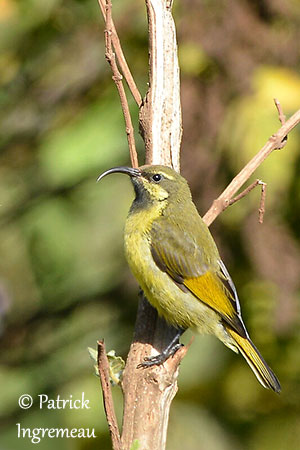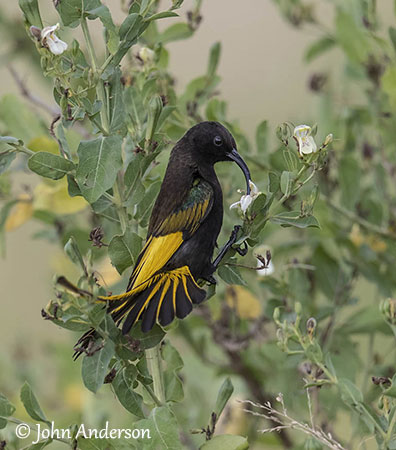
PROTECTION / THREATS / STATUS:
The Golden-winged Sunbird is described as common throughout its range.
The size of the population is unknown, but it is suggested to be stable. The Golden-winged Sunbird is not globally threatened and currently, this species is evaluated as Least Concern
Fr: Souimanga à ailes dorées
Ang: Golden-winged Sunbird
All: Goldschwingen-Nektarvogel
Esp: Suimanga Alidorado
Ita: Nettarinia alidorate
Nd: Goudvleugelhoningzuiger
Sd: guldvingad solfågel
Photographers:
John Anderson
John Anderson Photo Galleries
Jean Michel Fenerole
Photos d’Oiseaux du monde
Steve Garvie
RAINBIRDER Photo galleries & Flickr Rainbirder
Patrick Ingremeau
TAMANDUA
Text by Nicole Bouglouan
Sources:
HANDBOOK OF THE BIRDS OF THE WORLD Vol 13 by Josep del Hoyo-Andrew Elliot-Jordi Sargatal - Lynx Edicions – ISBN: 9788496553453
SUNBIRDS by Roberts A. Cheke, Clive F. Mann and Richard Allen Helm, 2001 - ISBN: 1873403801
BIRDS OF AFRICA SOUTH OF THE SAHARA by Ian Sinclair and Peter Ryan - Princeton University Press Princeton and Oxford - ISBN: 0691118159
NECTAR LOSS BY GOLDEN-WINGED SUNBIRDS TO COMPETITORS
Economics of Feeding Territoriality in the Golden-Winged Sunbird
Fatbirder - The World’s Richest Information Resource about Birds for Birders
CREAGUS@Monterey Bay (Don Roberson)
Wikipedia, the free encyclopaedia
Page Order Passeriformes
Summary cards
Golden-winged Sunbird
Drepanorhynchus reichenowi
Passeriformes Order – Nectariniidae Family
INTRODUCTION:
The Golden-winged Sunbird is a beautiful sunbird endemic to East Africa. It is found in DR Congo, Uganda, Kenya and Tanzania where it frequents bushy grasslands, forest edges, bamboo forest and cultivated areas, between 1,200 and 3,000 metres of elevation.
It feeds primarily on nectar from flowers of various species, but insects and larvae are also part of its diet.
It nests in a globular structure with an entrance hole, built by the female in shrub or at top of thistle or other plants, about 1/1,50 metre above the ground.
The Golden-winged Sunbird is described as common throughout the range, and currently, the species is not globally threatened.

DESCRIPTION OF THE BIRD:
Biometrics:
Length: M: 16-24 cm – F: 14-15 cm
Weight: M: 13-18 g – F: 11-16 g
The Golden-winged Sunbird male of nominate race in breeding plumage has black upperparts with bronzy-gold reflections on crown, mantle and back, whereas rump and uppertail-coverts are duller, less golden.
The long, graduated tail is black with golden-yellow outer edges to feathers. The central rectrices extend 70 mm beyond other feathers.
The upperwing is black with broad, golden-yellow edges to feathers, involving a gold appearance instead of black. Both median and lesser wing-coverts are more coppery. Primary and secondary wing-coverts and alula show green edges.
On the black underparts, chin and breast show copper and golden sheen. On the underwing, coverts and axillaries are black.
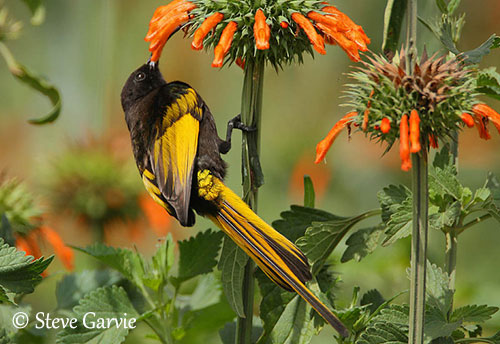
The head is entirely black with bronze gloss. Both male and female have a V-shaped bare groove between the bill and the forehead of nearly 1 centimetre. The pollen accumulates in this unusual feature when the bird feeds at flowers.
The conspicuously decurved bill is black with deep base. The eyes are dark brown. Legs and feet are black.
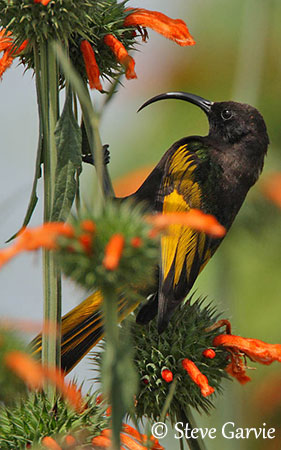
In non-breeding plumage, the male has dull black head, foreneck and back. There are only some metallic feathers on lower foreneck and back.

The adult female has dark brown top of head, lores and ear-coverts, but the crown shows olivaceous tinge. Chin and throat are pale yellow.
The upperparts are olive-green and slightly mottled brown. The tail is dark brown with golden-yellow edges. The central rectrices extend only 10 mm beyond other feathers. The wings are brown with yellow edges to feathers, forming a yellow wing patch when folded.
The underparts are dark olive-yellow with heavy dark brown mottling on centre of breast and belly. On the underwing, the coverts are blackish-brown with olive-yellow tips and axillaries.
The bare parts are similar to those of the male.
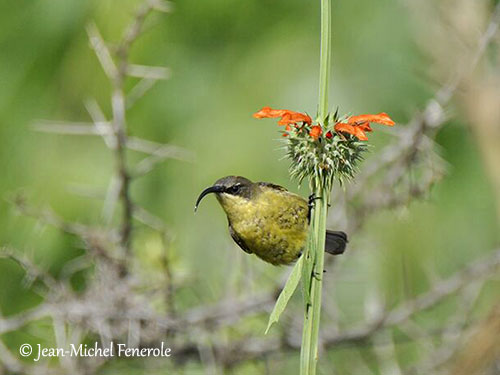
The juvenile/immature resembles adult female but it has black chin, throat and sides of face, whereas rest of underparts is olive with heavy black barring.
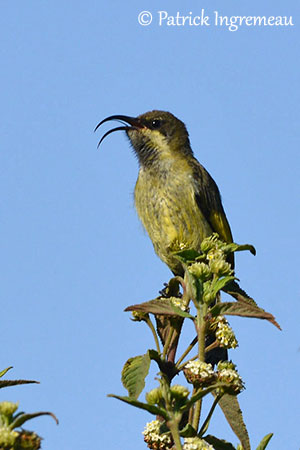
SUBSPECIES AND RANGE:
The Golden-winged Sunbird has three subspecies.
D.r. reichenowi (described above) occurs in S and W Uganda to W and C Kenya and N Tanzania.
D.r. shellyae is found in the mountains of DR Congo, NW of Lake Tanganyika, up and above 2,100 metres of elevation.
This race has less curved bill than nominate. The female has grey crown.
D.r. lathburyi occurs in N Kenya on isolated peaks, Mt Nyiru, Mt Uraguess and Mt Kulal.
This one has more strongly curved bill. The male may have stronger red reflections, but there are many individual variations, including in nominate race (here displayed).
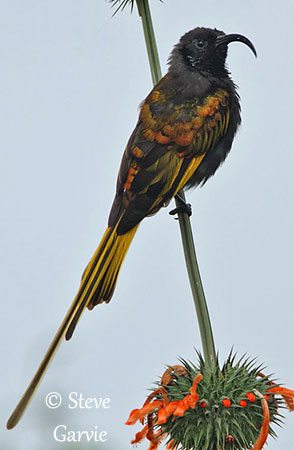
HABITAT:
The Golden-winged Sunbird frequents the bushy grasslands, clearings in bamboo thickets and the edges of the tropical mountain forest, between 1,170 and 3,300 metres of elevation. It is also observed in cultivated areas and gardens.
CALLS AND SONGS: SOUNDS BY XENO-CANTO
The Golden-winged Sunbird gives continuous “cher cher cher” and harsher, clipped “chik chik” notes. We can also hear some weak, rasping notes “jwee” and “tweep”.
The song consists of short bursts of twitters interspersed with a chatter, and also high-pitched “chi chi chi”.
BEHAVIOUR IN THE WILD:
The Golden-winged Sunbird feeds on various insect species such as Coleoptera, Hymenoptera and Diptera, but it also feeds on nectar from flowers. The flying ants are caught in flight.
While feeding on nectar, when the bird reaches inside flowers, the pollen accumulates in the bare, V-shaped groove between the bill and the forehead.
The Golden-winged Sunbird may forage in large feeding flocks with other sunbird species. It forms extensive foraging and feeding territories in patches of Leonotis nepetifolia. These feeding areas are strongly defended against intruders, and aggressive behaviour increases late in the day. They chase other birds away from the nectar sources, usually a patch of plants bearing flowers and nectar.

The Golden-winged Sunbird is territorial and monogamous. The reproduction may occur at any time of the year. The territory is usually defended by the male, singing from exposed perches and being aggressive towards intruders.
The courtship displays of this species are poorly known, but we can suggest that the beautiful coloured plumage and the long graduated tail of the male are enhanced during this behaviour. Copulation follows the elaborate displays.
The Golden-winged Sunbird nests in a globular structure placed in shrub or at top of thistle or other plant species. The nest is usually built by the female.
The Golden-winged Sunbird performs seasonal altitudinal movements related to food resources.
The flight is fast and direct on short, rounded wings.
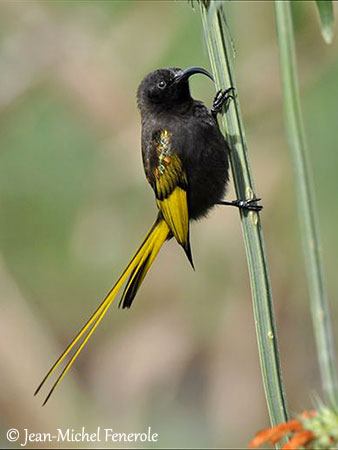
REPRODUCTION OF THIS SPECIES:
The egg-laying occurs in May in DR Congo, January and October in Kenya, and February and April in Tanzania.
The female builds a globular structure made with fine grasses, flower stalks and lichens, and lined with plant down. It is placed 1/1,50 metre in Leonotis plant, on top of thistle or in bush or shrub.
The race “shellyae” builds an entrance hole of 30 millimetres in diameter and also a porch.
The female lays a single whitish egg with darker markings. The incubation is probably by the female alone.
Information on incubation and nestling periods is lacking. However, the sunbirds usually incubate during about two weeks and the chicks are fed mainly by the female. The male may help after the chicks have fledged.
